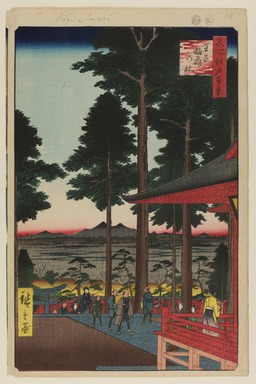
Artist:Utagawa Hiroshige
Medium: Woodblock print
Geograhical Locations:
Dates:9th month of 1857
Dimensions: Image: 13 3/16 x 8 5/8 in. (33.5 x 21.9 cm) Sheet: 14 3/16 x 9 1/4 in. (36 x 23.5 cm)
Collections:
Exhibitions:
Accession Number: 30.1478.18
Image: 30.1478.18_PS20.jpg,
Catalogue Description: Early spring scene from the Oji Inari Shrine, depicting the white puffs of plum blossoms from the gardens behind the teahouses below; the rice paddies beyond leading to Mount Tsukuba. Inari is a god of the harvest and Inari worship spread rapidly from the mid-tokugawa period throughout the rural Kanto hinterland of Edo, later moving into the city itself. The Oji area was in fact widely known for the foxes (messengers of the Inari god) that made their dens along the wooden ridge. The Oji Inari Shrine was considered the chief along all Knato shrines to Inari and it was near here that all the foxes of the region gathered on New Year's Eve (see plate 118). Oji Inari also sponsored an annual "kite market," since kite-flying was originally a rural New Year's custom for predicting the success of crops. Held on the first day of the Horse in the Second Month, the kite market still thrives today, although the kites are now constructed in the shape of Edo firefighters as amulets against fire. Hiroshige has not shown the kite market in this view, but the undertones are that farmers and city-dwellers alike prayed for a good year.